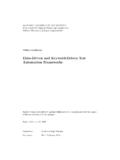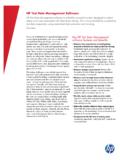Transcription of White Paper Test Automation - AgreeYa
1 Test Automation To be or not to be White PaperTesting is a form of Software Business Insurance. More coverage means less risk. And that s good news for : Adtiya Jainbuild (500 test cases) is released every week. During the first year, we have only considered the last 6 months as the initial phase which will comprise of tool/process setup and tester on Test Automation = Tool Cost (10 licenses) + Training Cost (if training internal resources) + Machine Cost (10 machines)# The cost of manually executing/running tests will increase as a result of annual increases in test cycles and the number of weekly builds and/or the number of test cases corresponding with every seen in the table above, the difference and the cost advantage comes only in terms of test execution. With test Automation , the testers will no longer be required to spend their valuable time on retesting something that has already been tested. Test Automation provides test engineers the space to be intuitive and allow them to focus their efforts on more rigorous note of caution, as time passes, new development techniques will become available and new sets of requirements will be requested.
2 As a result, the application will incorporate a new set of components, which the tool may no longer be able to recognize. Consequentially, one will have to upgrade or replace the tool altogether, involving re-investments such as new licenses, tester training and script development. This could lead to a reduced ROI, potentially urging firms to revisit their Automation strategy altogether. Choosing the right Automation toolIn the long run, selecting the right Automation tool is the most important factor that will ultimately decide the success of your test Automation project - poor choices unfortunately often result in project failure. During the culling process, current application view of performance test Automation simply because they know that it is logically not feasible to do it manually. Quick Tips:1. Automating an application whose UI changes frequently requires significant maintenance.
3 By the time necessary changes have been made to the script, the UI will change again, rendering most efforts useless. 2. Manual testing is recommended when the lifespan of the application is short and not many releases are of test Automation over manual testing Improved accuracy: Even the most seasoned and professional tester will make mistakes during monotonous manual testing. A tool performs the same task precisely every time. Increased test coverage: Complex test cases become easily executable with test Automation , providing coverage that was previously impossible with manual tests . 24/7 test environment: Test Automation allows for scheduling unattended test runs 24/7 -- the equivalent of having three daily 8-hour shifts of manual testing. Close alignment of test & development activities: Test Automation , when integrated with continuous-build software, provides a collaborative and continuous build-and-test environment.
4 This is particularly of importance in an agile environment. As soon as a build/code is submitted by the developer, tests are run automatically, notifying the developer of any errors. This increases the efficiency and effectiveness of developers and testers alike. Faster time to market: Test Automation provides testers the ability to execute tests 24/7 on multiple machines simultaneously, allowing complex and long regression testing to be executed in a fraction of time, and faster software delivery. Increased reusability: Done properly, test Automation offers immense benefits to testers in terms of case reusability. OverviewTo be or not to be, that is the test. It s a dilemma that many test managers face when considering test Automation . Test Automation can be a mixed set of affairs for organizations in terms of ROI based on varying results from different companies.
5 Given this set of mixed perceptions, many decision makers choose to avoid the long-term cost, and with it, the quality benefits that test Automation can offer. Some consider test Automation a pill for every ill, greatly overestimating its role in their overall test strategy. Still others understand the boundaries of this magic pill, take a marathon approach and build their entire test Automation concept around the existing overall test strategy, reaping maximum benefits. But of course, nothing is perfect. Test Automation , despite all of its glory, should only be used as a supportive role, and never as the primary or only activity in an organization s software improvement endeavors. In this whitepaper, we address key concerns and challenges around test Automation to help shed light on the truth behind this activity.
6 Myths about test Automation that affect good decision making One can achieve 100% test assumption or goal of 100% test Automation is not just impractical -- it s impossible. Test Automation is a one-time misconceived as a fire and forget tool, test Automation involves and demands continuous investment in the essential three: people, process and tools. Test Automation will simply do away with manual assumption cannot be further from the truth. test Automation at no point can replace the importance of manual testing or, for that matter, manual testers. Test Automation combats repetitive, mundane tasks and helps speed up execution. Moreover, it is not a substitute for walk-throughs, inspection, good project management, coding standards and solid configuration. Immediate reduction in test Automation , initial phases are often intensive, requiring a great deal of effort during setup.
7 Once the scripts and the optimized test suite are ready, there is a considerable decrease in resources and effort required. Based on the maturity of the product, test Automation requires and involves a certain degree of maintenance effort. 100% test cannot test anything and everything. The general philosophy is to primarily test what is important and repetitive. Anyone can automating tests , cases are scripted; this involves coding and technological development knowledge. Running tests quickly and more often results in better software s not about speed and quantity, but generally, running and continuously re-evaluating tests are what result in better drives test Automation ? Is it cost or is it quality?About 90% of organizations only undertake test Automation as a response to their failure in completing testing in the assigned timeframe. Sometimes, despite best efforts, quality goals have not been met, resulting in multiple defects in production.
8 Essentially, test Automation then becomes a last-resort, giving management three alternatives to choose from:(a) Hire more manual testers and grow the team organically.(b) Grow the team inorganically by outsourcing some part of their test activities to a third-party.(c) Begin evaluating software test Automation tools and the long-run, test Automation not only helps organizations deliver quality software faster, but it enables them to do so at a fraction of the cost. This economy of scale is not possible with options (a) and (b).Only 10% of organizations (those with matured test processes and practices) adopt test Automation to help with cost reduction. Adopting test Automation without proper practices and process (both development & testing) in place will result in a negative to automate and what not to automate?Test Automation is all about identifying the right things to automate after all, 100% adoption is impossible.
9 Ideal candidates for test Automation include: Sanity tests : Basic functionality rarely changes, making sanity testing ideal for Automation . This is particularly advantageous when handling multiple releases on a monthly basis. Regression tests : Save on costs and allow testers to solely focus on new functionality verification, avoiding repetitive tasks and eliminating risk in code change or bug fix issues. Unit tests : Inexpensive to write and maintain, unit test Automation results in the highest ROI, providing value to the team multiple times per day. Performance tests : Manually performing controlled web application tests with hundreds or even thousands of users is quite the challenging feat. With test Automation , users can simulate a large quantity of virtual users to check application load capacity. Management generally possesses very optimistic There are many applications where basic functionality remains the same; take, for example, the case of e-commerce applications, which are 80% similar.
10 The same test scripts, with little or no modification, can be used to test other applications, an option that is unavailable via manual testing. Benefit AnalysisIn this section, we will highlight the cost benefits that test Automation has to offer in terms of real ROI. To showcase this, we have taken some assumptions (based on experience from several Automation projects) which may vary by small percentage points from project to project. Number of test cases per test build: 500 (1 build every week) Average cost of a tool: $12,000 (single license) Hourly rate of a manual tester: $50 Hourly rate of a test Automation engineer: $60 Manual Maintenance Effort required/week: 4 hours Machine cost: $400 (each) Time to automate a single test case (script development): 1 hour Maintenance Effort required/week: 8 hours Time to manually execute a single test case: 10 minutes Time to write a single test case manually: 30 minutes Resource training cost $10,000*Considering two test cycles in a year, a test cycle of 6 months each.








